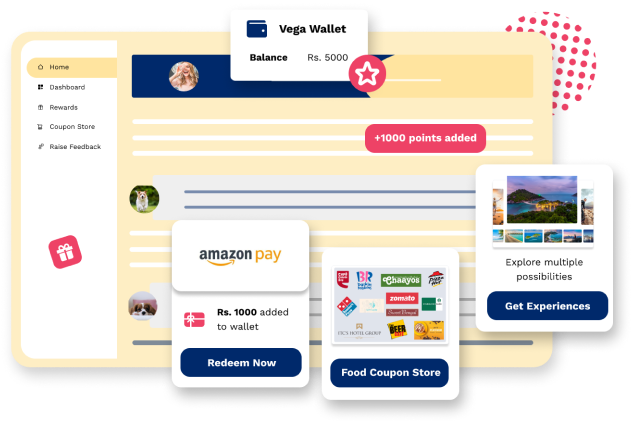The cost associated with replacing an employee may vary, spanning from 50% to 400% of their yearly salary.
Astonishing, right? 50% to 400% is no small range.
As an HR professional, your constant goal is to secure top-notch candidates for your open positions, and undoubtedly, retaining them is a primary concern.
But what is the key to attracting and retaining the best talent? Innovative compensation packages are the solution!
Compensation has crossed the boundaries of a mere paycheck; it's transforming into a comprehensive benefits program. This evolution is crucial in not only drawing in top-tier employees but also in fostering long-term commitment.
In this blog, we will explore the top 7 employee benefits and services that can be implemented, leading to optimal outcomes for your workforce.
What Are Employee Benefits & Why Are They Important?
Employee benefits refer to benefit programs for employees that extend beyond their regular monthly salary. They are an indirect form of compensation comprising fringe benefits.
The most common types of employee benefits and services include paid leaves, health insurance, and stock option plans.
But, why do companies opt to offer employee benefits above the conventional fixed compensation? Here’s why:
- It helps attract top-tier talent
- Results in low employee turnover
- Maintains a dedicated workforce
- Boosts employee productivity and professional growth
What Are the 7 Best Employee Benefits?
Types of Employee Benefits
Benefits at Work
- Flexible Work Arrangements
- Complete Office Setup
- Paid Time Off
- Learning Opportunities
Benefits for Health
Benefits for Financial Security
- ESOPs, RSUs, & Phantom Stocks
- Retirement Benefit Plans]
A significant majority, comprising 75% of employees, expressed their increased inclination to remain with their current employer due to the benefits offered in their program.
There are some excellent employee benefits and services gaining global popularity among HR professionals. Take a look!
1. Health & Life Insurance
Did you know that 58% of companies offer health benefits to employees? Also, 85% of millennials consider healthcare benefits to be both "absolutely essential" and "very important."
Today, offering healthcare and life insurance has become standard when extending an employment offer. Employees now anticipate affordable healthcare options, and as an organization, you have the opportunity to support this expectation. Corporate insurance, for instance, can significantly reduce hospital and medical bills by up to 80%, often extending coverage to dental and vision care.
It's noteworthy that many companies not only offer insurance to their employees but also extend this coverage to immediate family members, including parents, spouses, and children.
Also, telemedicine is gaining popularity. Organizations may opt to provide a yearly subscription plan for a healthcare app to their employees, facilitating hassle-free virtual one-on-one healthcare for both the employee and their immediate family members.
2. ESOPs, RSUs, & Phantom Stocks
Employees involved in ESOPs have a median tenure that is 46% longer than that of non-option stock owners, boasting an average of 5.1 years versus 3.5 years.
Organizations are adopting progressive approaches to employee benefit compensation through ESOPs, Restricted Stock Units (RSUs), and Phantom Stocks. The focus extends beyond conventional compensation, recognizing that attracting and retaining talent is key. ESOPs, RSUs, & Phantom Stocks align employee benefits with organizational growth, driving enhanced employee performance in support of broader organizational objectives. Also, these plans cultivate a sense of ownership among employees, improving overall job satisfaction.
If you’re confused about which equity plan to deploy within your organization, here is a table that clearly outlines the key differences between a phantom stock plan, a traditional stock option plan, and a restricted stock plan.
Feature
| Phantom Stock Plan
| Stock Option Plan
| Restricted Stock Units
|
Ownership Rights
| Phantom stocks represent notional shares; employees don't own actual shares.
| Employees receive actual stock options, providing direct ownership after vesting.
| Employees receive actual shares, providing direct ownership.
|
Cash vs. Stock Distribution
| Employees receive cash equivalent to the value of hypothetical shares.
| Employees exercise options to acquire actual company stock.
| Employees receive either actual shares of the company's stock or the cash equivalent of the stock's value upon selling the shares in the stock market.
|
Dividends
| Typically, employees receive cash equivalent of dividends on phantom stocks.
| Employees holding stock options may receive dividends if specified in the plan.
| Employees receive dividends or dividend equivalents, depending on the plan.
|
Exercise Price
| No exercise price; employees receive the appreciation value in cash.
| Employees must pay the exercise price to acquire the stock.
| No exercise price; employees receive the stock outright upon vesting.
|
Value Realization
| Employees realize value upon a triggering event, like a sale or IPO.
| Value realization depends on stock market performance, exercise decisions & liquidation events.
| Value is realized upon vesting, determined by the market value of the company's stock at the time of vesting.
|
Taxation
| Taxed at the time of payout as ordinary income.
| Taxed upon exercise as ordinary income and capital gain tax at the time of sale of exercised shares.
| Taxed upon vesting as ordinary income.
|
3. Flexible Work Arrangements
76% of workers would actively pursue alternative employment opportunities if their existing employer eliminated flexible work arrangements.
Looking at such data, it is impossible to deny that hybrid/remote work policies are not just a modern trend but a key necessity.
Empower your workforce with the freedom to work remotely, coupled with flexible work hours. Establish a designated time for team and department collaboration. This way, you can foster effective communication, enabling the collective discussion of challenges and strategic planning for the future.
In addition to remote work and flexible hours, consider introducing compressed workweeks. This option provides further adaptability, allowing employees to tailor their schedules to optimize productivity while maintaining a healthy work-life balance. for example, instead of working eight hours a day for five days (40 hours in total), an employee might work ten hours a day for four days (also totaling 40 hours).
These flexible work practices help enhance employee satisfaction and also contribute to a more agile organizational culture.
4. Short Term Rewards
Boosting employee morale is a key aspect of short-term rewards, and implementing appreciation programs is a strategic move in this direction.
Utilizing tools like Vega HR facilitates seamless acknowledgment through its Social Intranet feature, providing managers with a convenient platform to recognize and reward their teams instantly.
Moreover, incorporating Nomination and Milestone Based Awards via the platform acts as a potent motivator, ensuring that employees experience immediate gratification for their efforts.
Taking it a step further, the Happiness and Mood Index within the solution enables real-time monitoring of employee satisfaction, allowing proactive measures to be taken for an immediate enhancement of the overall workplace experience.
5. Paid Time Off
According to a study, the adoption of formal policies promoting employee well-being has seen a notable increase, rising from 65% in April 2021 to an impressive 86% among organizations. These policies include paid time off, parental leave, and flexibility, reflecting a growing awareness and commitment among employers to support the overall welfare of their workforce.
Consider the convenience of being able to apply for sick or casual leave without the looming concern of pay cuts. Today's progressive employers go beyond, extending compassionate care and bereavement leaves, fostering an environment that promotes a healthy work-life balance.
And let's not overlook the invaluable offering of paid parental leave,. While maternity leaves are mandated in most countries, forward-thinking organizations are swiftly normalizing paternity leaves for men, acknowledging and adapting to evolving societal expectations. As shared by Takeshi Nakashima, Assistant Manager at Nissan Global , “Focus on child and house chores and don't work during paternity leave, no matter what. Never check emails, either!”
The adoption of paid time off, extended leave options, and an understanding approach toward personal situations all contribute to creating a workplace where employees feel valued and supported, ultimately fostering a more engaged and loyal workforce.
6. Learning Opportunities
Employees no longer wish to be stuck up at their workplace for years. They actively seek challenges to expand their skill sets.
To support their professional growth, organizations must prioritize employee training and development. Identify the skills that will improve their capabilities and provide them with targeted training for the same. Also, allow them to apply their newfound knowledge in their roles.
Moreover, recognizing that employees may have specific educational goals, organizations can further support them by offering financial assistance for courses or training programs.
Apart from these structured training programs, facilitate a culture of mentorship and knowledge-sharing. Encouraging collaboration and cross-functional interactions can help employees benefit from the diverse expertise within the organization. This not only boosts individual skills but also contributes to the collective growth and adaptability of the entire team.
7. Retirement Benefit Plans
As per an SHRM study, 77% of individuals view retirement savings as their most important benefit.
Retirement plans play a key role in securing an employee's future, providing them with peace of mind and the ability to visualize a comfortable retirement.
In addition to the immediate advantages of financial security, offering robust retirement plans can significantly contribute to employee loyalty and retention. Employees who feel supported in planning for their future are more likely to stay committed to their current employer. It sends a powerful message to employees that their employer values their long-term financial health and recognizes the importance of a holistic approach to employee benefits.
Furthermore, organizations that actively promote financial literacy alongside their retirement plans equip employees with the knowledge and tools to make informed decisions about their financial future.
These are just some of the top benefits. Other benefits span a wide range, including sustained employee engagement through consistent activities, a well-equipped office setup fostering productivity, enhanced collaboration and communication, and streamlined processes leading to increased efficiency.
Wrapping Up
Your ideal candidate seeks more than just a competitive salary; they are actively searching for additional perks to enhance their overall work experience.
Do you currently offer a comprehensive benefits program for your employees? Are you prepared to elevate your appeal to attract and retain top-tier candidates?
We are confident that the above-mentioned benefit programs can play a crucial role in not only attracting but also retaining valuable talent. Wishing you the best of luck in achieving a successful employee retention ratio!
About Vega HR
Vega-HR is a powerful tool in the talent war, offering employee rewards, recognition, and pulse recognition. With an engaging platform, it fosters a world-class work culture, providing P2P recognition, social feedback, on-spot recognition, and monetizable incentive solutions with 3000+ coupons in various categories.
Create a Culture People Want to Stick to
- Send rewards
- Give shoutouts
- Build a community
- Gift experiences
Get a demo
 Written by Shubhika Sundriyal 16 April 2024 | 4 min read
Written by Shubhika Sundriyal 16 April 2024 | 4 min read




